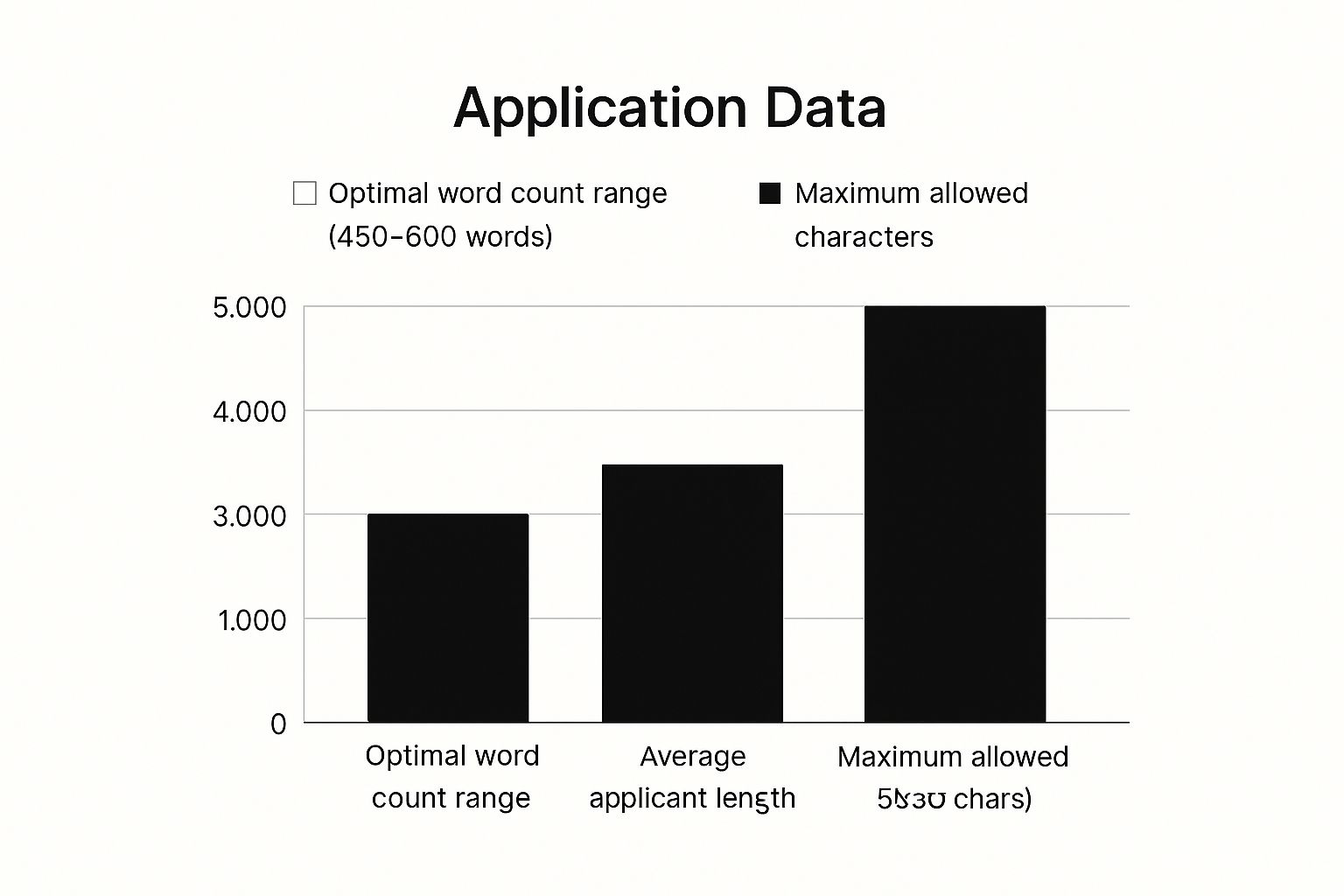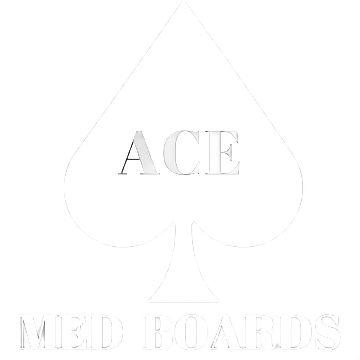When it comes to the ERAS personal statement, the official character limit is a bit of a red herring. Yes, the system gives you a massive 28,000 characters, but treating that number as a target is one of the biggest mistakes you can make.
Think of it this way: your goal is to make a powerful, memorable impression on program directors who are drowning in applications. A concise, single-page statement respects their time and proves you can communicate effectively—a critical skill for any physician. It’s your elevator pitch, not your life story.
Decoding the ERAS Character Count
Let's clear up the confusion around the ERAS personal statement length. That 28,000-character limit is a technical maximum set by the system, not a suggestion from program directors. It’s like a highway with a 100 mph speed limit; just because you can go that fast doesn't mean you should.
The unwritten rule—the gold standard, really—is a compelling, single-page statement. Sticking to this shows professionalism and your ability to distill complex information into its most essential parts. After all, the full limit could stretch to nearly 20 pages, and no program director has time for that. For more on this, OnlineMedEd offers great insights into why brevity is so crucial.
To put it in perspective, here's a quick summary of the official limits versus what you should actually aim for.
ERAS Personal Statement Length At a Glance
This table breaks down the technical limits and our recommended targets to help you stay on track.
| Metric | Official ERAS Limit | Recommended Target |
|---|---|---|
| Characters | 28,000 (with spaces) | 3,500–4,500 |
| Words | Approx. 4,500–5,000 | 600–800 |
| Pages | 15-20 | 1 |
As you can see, the sweet spot is a small fraction of the maximum allowed. This isn't about filling space; it's about making every single word count.
The Technical Limit vs. The Practical Ideal
The gap between the allowed character count and the ideal length is massive. This infographic really drives home just how different the technical maximum is from the sweet spot you should be aiming for.

This visual makes it crystal clear: successful applicants don't get anywhere near the official limit. Your focus should always be on quality and impact, not quantity.
Viewing Your Statement in ERAS
Formatting issues can completely derail a great personal statement. The only way to know for sure how it will look to program directors is to use the preview function within the ERAS application itself.
Don't skip this step! It’s your final quality check to catch any weird line breaks or formatting quirks before you hit submit. This is absolutely critical for ensuring your story comes across as clean, professional, and polished as you intended.
Why One Page Wins Over Program Directors

Picture this: you're a program director buried under a mountain of applications. Hundreds of files are stacked on your desk, and it feels like the pile never shrinks. This isn't an exaggeration; it's the reality of application season, and it leads to a very real problem called application fatigue.
Now, imagine you open a file and the personal statement spills onto a second page. It might seem like a small detail, but it can unintentionally signal that the applicant doesn't respect your incredibly limited time. Your statement is often the first real glimpse they get of your personality, making it a critical first impression.
A powerful, concise one-page narrative does the opposite. It immediately communicates professionalism and shows you can distill your entire medical journey into a clear, compelling story.
Communicating Confidence and Clarity
Sticking to one page isn't just about saving space—it's a strategic move. It tells the committee, "I know what's important, and I can deliver it efficiently." This skill is priceless in medicine, where communicating clearly and concisely under pressure is a daily requirement.
A long, rambling statement doesn't just waste time; it dilutes your most powerful points, burying them in a sea of unnecessary detail. A focused essay ensures your key experiences pop off the page, making your application memorable for all the right reasons.
Think of it as the first time you present a patient to an attending. You wouldn't list every single minor detail from the patient's history. You’d give a sharp, relevant summary that gets straight to the point. Your personal statement deserves that same clinical precision.
This isn't just our opinion, either. Based on data from advisors who have guided over 5,000 applicants, a staggering 94% of those who kept their statements to one page successfully matched into a top-choice program. You can dig into more residency admissions insights to see how statement length impacts success.
Ultimately, making a program director's job a little easier can be the small advantage that makes your application stand out from the stack.
Crafting Your Story Within the One Page Limit

Knowing the ideal length for your ERAS personal statement is one thing, but actually writing a powerful story that fits is a whole different ballgame. A compelling one-page statement isn’t just about being short and sweet—it's about being incredibly strategic with how you build your narrative. Think of it like constructing a bridge: every single piece has to be perfectly placed to support the entire structure.
Your mission is to elevate a simple list of your accomplishments into a cohesive, memorable story. Every sentence needs to pull its weight, pushing the narrative forward and reinforcing your central message. If you’re staring at a blank page and feeling stuck, you might want to explore some techniques to spark creativity and ignite ideas to get the ball rolling.
The Proven Narrative Framework
The most successful personal statements almost always follow a clear, three-part structure. This simple framework gives your story a logical flow, making it easy for busy program directors to read, absorb, and—most importantly—remember.
- The Hook (Introduction): Your first paragraph absolutely must grab their attention. Kick things off with a powerful anecdote or a defining moment that immediately showcases your passion for your chosen specialty.
- The Growth (Body Paragraphs): This is where you bring your journey to life. Dedicate the body of your statement to 2-3 pivotal experiences. But don't just list what you did; reflect on what you learned from each experience and how it fundamentally shaped you as a future physician.
- The Vision (Conclusion): Your final paragraph is all about connecting the dots between your past journey and your future goals. State clearly why you're a fantastic fit for their program and what you're excited to achieve with them.
A well-structured statement does more than just list achievements; it reveals your thought process, resilience, and unique perspective. It’s the difference between a resume and a story.
Sticking to this structure keeps you focused and ensures your statement is impactful from the first word to the last. To see this framework in action, it can be incredibly helpful to review a https://acemedboards.com/sample-personal-statement-medical-school/ for inspiration. By focusing on a clear beginning, middle, and end, you can craft a memorable story that fits perfectly within that one-page ideal.
Navigating ERAS Formatting and Technical Limits

The ERAS portal is infamous for its formatting quirks. Many applicants have learned the hard way that it can turn a beautifully written statement into an unreadable block of text in seconds.
The most common mistake? Copying and pasting directly from a program like Microsoft Word or Google Docs. These programs sneak in hidden formatting code that ERAS simply doesn't understand, resulting in jumbled paragraphs and bizarre symbols appearing out of nowhere.
Think of it like trying to play a modern streaming file on an old VCR—the technologies are completely incompatible. The only way to win is to strip your statement of all formatting before it ever touches the application portal. This ensures your story shows up exactly as you want it to, without any technical glitches.
The Plain Text Editor Solution
Your best weapon against this formatting chaos is a simple plain text editor. Every computer comes with one: Notepad for Windows users and TextEdit for Mac users are perfect for this. These basic programs work only with raw, unformatted text. No bolding, no italics, no fancy fonts.
This limitation is actually your biggest advantage. By writing your final draft in a plain text editor—or pasting it there first—you scrub away all that invisible code. What's left is a clean version that is 100% compatible with the ERAS system.
Remember, the ERAS application is a great equalizer. It intentionally ignores rich text formatting to make sure every single application looks uniform to program directors. A plain text editor helps you work with the system, not against it.
Once your statement is clean in the plain text editor, you can confidently copy and paste it into the ERAS application. This one extra step is the single most effective way to avoid last-minute formatting nightmares and submit a clean, professional document.
Proven Techniques to Edit Your Statement Ruthlessly
Your first draft is almost guaranteed to run over the ideal one-page length—and that’s actually a good thing. A truly powerful personal statement isn’t written in a single sitting; it's carved out with precise, sometimes ruthless, editing. The goal is to trim the fat without losing your voice or diluting your core message.
Think of yourself as a sculptor who starts with a huge, raw block of marble. That's your first draft. Now, it's time to chip away everything that isn't part of the final masterpiece. This process is what transforms a good story into an unforgettable one.
The Art of Self-Editing
Effective editing requires you to step back and be objective, which isn't always easy with your own writing. One of the best ways to do this is simply to read your statement out loud. This trick immediately exposes awkward phrasing, sentences that drag on forever, and spots where your tone just feels off.
Another critical technique is what writers call "killing your darlings." This means you have to be willing to delete beautifully written sentences or touching anecdotes that, while eloquent, don't directly support the main narrative of why you're a perfect fit for this specialty.
Every single word in your statement should serve a purpose. If a sentence doesn't advance your story, showcase a key quality, or connect to your specialty, it has to go. No exceptions.
It can be tough, but this is how you ensure your final essay is focused, tight, and impactful. As you work on refining your statement, keep the deadlines in mind. You can get a full picture of the submission schedule by checking out our guide on the ERAS application timeline.
Your Tactical Editing Checklist
To make this less abstract, here’s a tactical checklist to help you attack your draft. Challenge every word, every sentence, to justify its place on the page.
- Hunt Down the Passive Voice: Flip sentences like "The patient was seen by me" to the much stronger "I saw the patient." Active voice is more direct, confident, and almost always uses fewer words.
- Slash Weak Adverbs and Adjectives: Search for words like "very," "really," "truly," and "extremely." Strong verbs and nouns don't need these helpers. Let your actions and descriptions speak for themselves.
- Eliminate Cliché Phrases: Get rid of tired expressions like "I've always wanted to be a doctor" or a generic "passion for helping people." Instead of telling the committee, show them with specific, compelling examples from your experiences.
- Combine Short, Choppy Sentences: Look for places where you have several short sentences in a row covering related ideas. Merging them can create a more sophisticated and readable flow.
Answering Your Top ERAS Personal Statement Questions
Let's clear up some of the common questions and gray areas that pop up when you're finalizing your ERAS personal statement. Getting these last few details right can make all the difference, giving you the confidence that you’ve put your best foot forward.
One of the biggest questions I hear is: "Do I really need to write a unique personal statement for every single program?" The short answer is no. For most applicants, trying to write dozens of unique essays is not only impractical, it's completely unnecessary.
A single, powerful personal statement that’s polished to perfection for your chosen specialty is exactly what you need for the vast majority of your applications. The goal is to create one stellar document.
That said, there's a smart way to give your absolute top-choice programs a little extra attention.
How to Tailor a Statement for Your Dream Program
For that small handful of programs you'd be thrilled to match with, adding a touch of personalization is a fantastic strategy. This doesn't mean you need to rewrite the whole thing. Instead, just tweak the final paragraph.
- Get Specific: Mention a faculty member whose research genuinely excites you. Reference a unique clinical track or community outreach program that perfectly aligns with your career goals.
- Show You've Done Your Homework: This small effort sends a huge signal. It tells the program director you aren’t just bulk-applying; you have a sincere, informed interest in their specific community.
- Keep It Short and Sweet: You only need a sentence or two to make this connection. It’s a powerful punch that won’t disrupt the narrative you’ve already built.
Making Sense of Character Counts and Page Limits
Another point of confusion is always the technical stuff. The official ERAS limit is 28,000 characters. It’s important to remember this includes everything—every letter, space, and punctuation mark. This is a hard-and-fast limit set by the system itself.
Now, what about the "one-page rule"? While spilling a few lines onto a second page won't get your application tossed out, sticking to one page is the gold standard. Think of it as a professional courtesy. Program directors are reading hundreds of these, and a concise, single-page statement shows you respect their time.
If you’re having trouble cutting your story down to size, our guide on how to write a personal statement offers some great frameworks for writing with impact and brevity. Your goal is to make sure your entire story gets read, and keeping it concise is the best way to do that.
